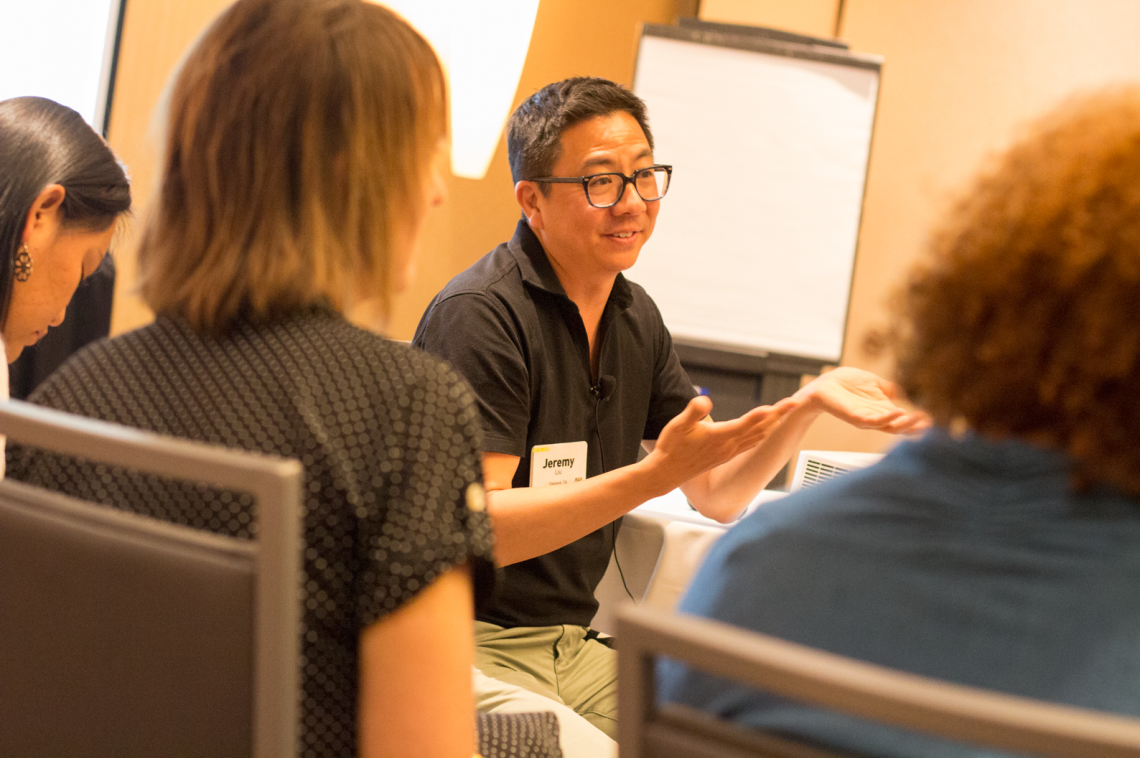
ArtPlace America strives to make investments in projects that achieve real, sustainable change through creative placemaking. But how do we know change is happening? How do we measure it, quantify it and document it?
At this year’s ArtPlace Summit in Phoenix, AZ we asked our attendees to focus on examining their experiences with defining progress.
In the “Turning Within: Accommodating New Ways of Working” breakout session, we heard from Brian Friedman, executive director of Northeast Shores Development Corporation in Cleveland, OH, about his organization’s mission to revive Cleveland’s Collinwood neighborhood, an area deeply impacted by the housing and foreclosure crisis.
Originally started as a community development corporation focused on housing, in the last decade Northeast Shores has shifted their focus to engage with artists to bring positive change into the area. After receiving a Community Partnership for Arts & Culture grant five years ago, Brian and his team began to integrate the arts into all of their projects. “We started to ask ourselves, ‘What if art was in every single thing we did?’” he told the group.
Instead of viewing the neighborhood’s vacancies as a problem, Northeast Shores saw them as an opportunity to offer affordable housing to artists. They began by inviting a chalk muralist to work outside during one of their open houses and the rest is history. Since then, the organization has attracted over 60 artists to relocate to Collinwood in just five years.
“How do we know this is actually working? One of the things we’ve been doing is tracking how residents believe the neighborhoods have changed over the last 5 years using surveys,” Brian explained.
The surveys – combined with a new “Ballot Box Project” where the community votes on how arts can engage in what’s happening in the neighborhood – have increased community engagement overall and have helped Brian and his team convince more traditional, local funders to continue to support Northeast Shores’ work.
Northeast Shores is a great example of how organizations can accomplish change using the arts without building a separate arts and cultural practice outside of their line of work. But what is it about the arts that drives such success, anyway?
Lyz Crane, deputy director of ArtPlace America, posed the question “What exactly are the unique qualities that artists are bringing to the table? When are they enhancing good community development strategies and when are they fundamentally shifting the way community engagement happens?” She also added “Artists seem to be able to reach more people and have conversations about hopes, needs, and desires in new ways that go beyond a traditional town hall meeting.”
In some cases, the quality of the end artwork isn’t really the main point, it’s about engaging with people through artistic mediums – many of which seem to level the playing field and invite all members of a given place to participate. “It’s a shift." Maria Rosario Jackson, senior adviser to the Arts & Culture Program at The Kresge Foundation, said.
There’s tremendous value in documenting that cultural shift, but how do we do so? How do we integrate the documentation process into our work? How do we know when success has been achieved and it’s time to stop working or work differently?
Those questions were the focus of the “Creative Documentation: Balancing Knowing and Feeling” breakout session.
Lynn Osgood, an urban designer and planner for GO collaborative in Austin, TX, got things started with a discussion of her work with the Drawing Lines project. Drawing Lines began in response to Austin’s decision to change from an at-large system of governance to a district specific system. Lynn and her team wanted to find out how this remarkable shift would affect cultural arts in the city.
They ended up placing an artist in each of the new districts to co-create art about the district with local residents. To make sure the artists were able to move freely through the community, Lynn and her team had to take a step back, hand over some trust, and merely act as a resource. What resulted was a series of projects which simultaneously engaged the community and documented real change.
In district three, for example, Grammy Award-winning musician Adrian Quesada worked with high school kids in the district to teach them about cumbia music, later creating a collaboration between the kids and Johnny Degollado, the 80 year old local accordion legend to make a district song and video.
“What we found,” Lynn told us, “was that artists were a very grounded witness to the people and the places of Austin… We made time to witness each district [through the artwork]. We’ve [seen] the success in the way that we have moved the needle with different council members and their understanding of the arts. Before the project, many didn’t personally identify with the arts, and now they do.”
More often than not, however, the progress and change that the arts offers is difficult to enumerate.
Jeremy Liu, senior fellow for the arts, culture and equitable development at PolicyLink discussed how artists can (or cannot) function as researchers and offer those answers. He said, “There is so much more that can be accounted [for] with an artist’s process participating in the research than simply the qualitative or the quantitative. We want to pay attention to the outcomes and goals that organizations are setting, but we want to also pay attention to the process and the other less tangible things that are happening.”
“There’s as much to learn about what [organizations] realize once they have to shift their processes as there is from the final work of an artist,” he added.
In this field, clear-cut, easy answers are hard to come by. There may not be a concrete method for tracking change that happens through the arts yet, but our attendees seemed to agree that lots of headway is being made through the creative documentation process.





